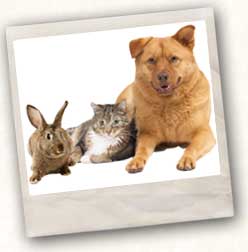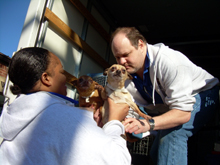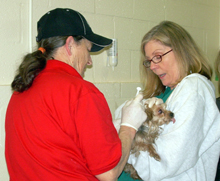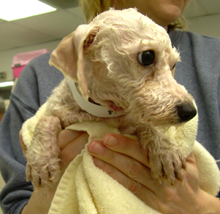This is almost a preview of the Ad Council’s upcoming PSA campaign, the Shelter Pet Project! (The campaign launches 9/24 — in conjunction with HSUS and Maddie’s Fund.) Make adoption your first option!
Vodpod videos no longer available.
September 14, 2009
This is almost a preview of the Ad Council’s upcoming PSA campaign, the Shelter Pet Project! (The campaign launches 9/24 — in conjunction with HSUS and Maddie’s Fund.) Make adoption your first option!
Vodpod videos no longer available.
August 4, 2009
Pet-focused reading program aims for empathy
Group hopes to help kids learn responsible pet care, prevent animal cruelty
By Linda Lombardi for The Associated Press
Wheaton, MD
August 3, 2009
—
Details about the United Animal Nations HEAR program:
Humane Education Ambassador Readers
June 3, 2009
DeFord points out yet another perspective on Vick:
Sweetness and Light, Morning Edition, June 3, 2009
http://www.npr.org/templates/story/story.php?storyId=104831602
May 27, 2009
There’s certainly more than one way to look at Michael Vick and HSUS. Here’s Nathan Winograd, on his blog:
In bed with monsters
5/25/09
To which I reply, yes, HSUS does adopt some very questionable policies, to say the least. HSUS also adopts some very progressive policies, at least on the outset. So do we throw the baby out with the bath water? Or do we work from inside to try to change the system?
For those of us who believe HSUS does have at least some merit, I say it’s up to us to help other folks understand what programs they do and do not undertake. If you want to support animal welfare directly rather than through advocacy, put your nonprofit dollars into local or small, struggling organizations with a valiant mission, where every penny makes a legitimate difference in animal lives. These organizations still are able to draw on the HSUS knowledge base, which is considerable in spite of some of the criticism from those with an opposite political philosophy. And HSUS’s advocacy efforts are still effective in many ways at saving animal lives on a macro level.
There’s room in my playbook for some of what HSUS is all about, and also some of what Nathan Winograd is all about. I’m for picking the best practices each has to offer rather than pitting one against the other. The latter more closely resembles a dog fight. I thought that’s what we’re all against, folks!
May 20, 2009
Humane Society open to working with Michael Vick
USA Today, 5/20/09
The humane thing to do: Give Vick a second chance
by Tom Tryon, Sarasota Herald-Tribune, 5/24/09
Campaign against dogfighting comes to Atlanta
Event comes on eve of Michael Vick’s release from prison
By Alexis Stevens, The Atlanta Journal-Constitution, 5/19/09
Does Michael Vick really mean it when he says he’s sorry? He hasn’t apologized to the dogs. Is he just claiming remorse so he can get on the good side of a new football team and get his game back? Or will he demonstrate that he’s changed not only his attitude but his behavior as well?
The latter is certainly to be preferred. I’ve thought from the beginning that a constructive approach would be more effective for helping him change direction than a rigidly punitive approach — see my Web of Life blog right around the time of his sentencing hearing for a bit of historical context.
Think about it: If you accept the logical premise that any animal can be trained to be either calm or vicious, or deliberately provoked to the point of becoming aggressive, then you may be receptive to the main idea behind positive training. In essence, this kind of training rewards the desired behavior. When an animal performs an undesirable behavior, that is simply not rewarded.
There are plenty of variations on that theme — counter-conditioning, desensitization, negative reinforcement, and others. You can teach an animal what you want by trading an undesirable behavior (aggression) for an acceptable behavior (sit politely, the equivalent of saying please before granting something of higher value, also known as “no free lunch”).
And I suggest that you can use these same principles on people, to direct their behavior as well. Works with kids, works with college students. Perhaps even with tough guys, too. It’s not for counselors or rehabbers who want a quick fix for their clients, but rather, for those who are willing to invest in the long haul. With dogs, the difference between positive training (think Victoria Stilwell) and dominance (think Cesar Milan) is that with positive, the dog learns to give the behavior because he wants to. In contrast, with dominance, the dog gives the behavior out of fear of what will happen if she doesn’t. Make the reward for good behavior so attractive that it effectively becomes the only choice.
So yes, maybe getting to play football again is such an attractive reward for Michael Vick that doing good with The Humane Society of the United States becomes a behavior he would actually be eager to demonstrate. If that comes to pass, the practical result would make him an ambassador for both humane education, reform, and sport.
Breeds that mislead
Cary Smith, DC Pets Examiner, 5/20/09
What’s next for Michael Vick?
Wayne Pacelle blog, The Humane Society of the United States, 5/20/09
If anyone was ever in need of an extreme makeover, it’s Michael Vick
Published by Tim Collette on SeahawkNationBlog.com, 5/13/09
(Note — Collette suggests a good list of “rehab” community service projects for Vick)
—
Is Michael Vick genuinely sorry for what he did?
Can he be effective in helping HSUS combat dog fighting?
Can he be an effective role model for disadvantaged kids, as Wayne Pacelle suggests?
May 11, 2009

I’m not sure who the original author is, but I am sure this describes gazillions of us.
Happy Fur-Mom’s Day to us!
May 7, 2009
I am deliberately writing “no kill” in lower case letters because that’s largely what I heard at last weekend’s conference in DC, organized by Nathan Winograd and the Animal Law Project at George Washington University. Perhaps some of the sessions I didn’t make it to were more “political,” but the ones I did hear would have been useful in a fairly wide variety of settings.
Controversial or not, there’s no denying a bunch of techniques and strategies animal welfare folks can implement that will change from outcomes that create or sustain suffering for animals to outcomes that improve their quality of life. These strategies ultimately end up saving their lives. In a nutshell, that’s what shelters are supposed to do in the first place.
Some people are adamantly opposed to no-kill. Not all of the techniques presented and discussed during this conference are right or adaptable for all shelters. But that doesn’t mean the movement is all wrong.
What others are saying:
See Kim Thornton & Christie Keith blogging at PetConnection
Archives:
March 13, 2009
After the strain of living their entire lives until recently in an alleged puppy mill in North Carolina, the first of the 15 dogs received by the Montgomery County Humane Society have found the warmth of human contact and new loving homes.

Nana, now known as Pumpkin, was the first to be adopted. A small white poodle mix, she was somewhat intimidated at first, says adopter Kathleen Fornatora, from Ashton. “But she’s adjusted wonderfully well,” Fornatora says. “She’s coming out of her shell and is more relaxed. She just bounces at mealtime.”
At first, Pumpkin would simply sit on her new mom’s lap for a couple of hours, watching TV. She tolerates getting her toenails trimmed, but at only nine pounds, Fornatora says she’s easy to manage.
Pumpkin now walks out of her crate on her own, rather than waiting for someone to reach in for her. Her housetraining is progressing as well, no small feat for a puppy mill survivor. Thanks to confinement to a cage their entire lives before now, these dogs are trickier to train.
 Most recently, Amber, a tiny Chihuahua who has been renamed Kiki, went home with Tana Stellato and her son Jason, 17. Her family is experienced with rescue pets – their previous dog, Sabrina, was also a puppy mill survivor who lived 16 years under their loving care.
Most recently, Amber, a tiny Chihuahua who has been renamed Kiki, went home with Tana Stellato and her son Jason, 17. Her family is experienced with rescue pets – their previous dog, Sabrina, was also a puppy mill survivor who lived 16 years under their loving care.
“Kiki is so sweet and really doing well,” Stellato says. “She was slow to eat and drink the first 24 hours while she was checking out her new environment, but now everything appears normal.”
Stellato says Kiki is also smart. She already knows how to sit on command and understands “outside” when it’s time to do her business. She loves her little bed and wants to be petted a lot. “I never leave her alone,” Stellato adds.
Upon arrival last month at the MCHS Private Rescue in Rockville, the dogs were groomed and examined by a veterinarian before being made available for adoption. Prospective adopters are advised that there needs to be an adult at home around the clock and extra precautions are important to help the dogs adjust to everyday activities most people and pets take for granted. Commitment to the animal’s rehabilitation is key, whether for housetraining, feeding treats, or playing.
FAQs on Rehabilitation of a Puppy Mill Dog
March 8, 2009
Hey, kids and teens attending schools in Montgomery County, Maryland! Here’s a cool pair of contests for you to learn and show what you know about what it means to be a responsible animal caregiver. As a project for the Montgomery County Humane Society, a team from the Leadership Montgomery organization has organized an art poster contest for students in grades 2-5, and a YouTube PSA video contest if you’re in grades 6-12. Read the full contest rules
Rules to Love By: 10 Commandments of Responsible Pet Ownership
 1. I’m probably going to live 10 to 15 years. Please keep me my entire life. To be separated from you would be very painful.
1. I’m probably going to live 10 to 15 years. Please keep me my entire life. To be separated from you would be very painful.
2. I’m a slow learner. I need some time to understand what you want of me.
3. Give me food and exercise every day. To stay healthy, I need the same kinds of things you need.
4. Please have me spayed (if I’m a girl) or neutered (if I’m a boy). I will be a better pet and you won’t have to find safe homes for all my babies.
5. You are my best friend. Please don’t stay mad at me or lock me up as punishment. I can’t understand why you’re doing that.
6. Talk to me. I like hearing your voice, even if I don’t understand what you’re saying.
7. I don’t hurt you. Please don’t hurt — or hit — me.
8. Before you yell at me for acting lazy or not doing what you say, remember I might be tired, hungry or sick.
9. Take care of me when I get old. One day you’ll need someone to take care of you, too.
10. Stay with me when I’m scared. I feel safe when you’re around.
See a sample of the kind of video you can produce
DEADLINE UPDATED FOR BOTH CONTESTS:
April 15, May 1, 2009
###
February 19, 2009
(This is one of my articles in the Fall 08-Winter 09 issue of Animail, published by the Montgomery County Humane Society)
Sweet NC puppy mill survivors receive TLC at MCHS Rescue
 Just in time for Valentine’s Day, the Montgomery County Humane Society saved 15 dogs rescued a week earlier from a puppy mill in Wayne County, NC. Mostly small breeds – Yorkies, Poodles, Chihuahuas, Pomeranians and Shih-Tzus – many were emaciated, severely matted, had overgrown their collars, and were suffering from dental and other serious medical ailments.
Just in time for Valentine’s Day, the Montgomery County Humane Society saved 15 dogs rescued a week earlier from a puppy mill in Wayne County, NC. Mostly small breeds – Yorkies, Poodles, Chihuahuas, Pomeranians and Shih-Tzus – many were emaciated, severely matted, had overgrown their collars, and were suffering from dental and other serious medical ailments.
The scene on the day of their arrival showed MCHS teamwork in action. Staff and volunteers lined up at the MCHS Private Rescue to welcome the dogs and start them on the path to recovery and love. Some had severely matted coats, all were filthy, and all had overgrown nails.
“It is appalling that any breeder would allow animals to be raised this way,” said MCHS President and CEO Cris Bombaugh. “These dogs are now getting the medical attention, grooming and TLC they so badly need with our staff and volunteers.”
Truly the lucky ones
A year-long investigation by The Humane Society of the United States into Thornton’s Kennels led to the seizure of these dogs. The HSUS and Wayne County Animal Control partnered to rescue almost 300 neglected animals. Volunteers with United Animal Nations oversaw a temporary emergency shelter in North Carolina.
 As the dogs were handed from person to person coming off the truck in Rockville, each one was given a core vaccine and examined for ear mites and eye infections. All allowed themselves to be held close by gentle human arms.
As the dogs were handed from person to person coming off the truck in Rockville, each one was given a core vaccine and examined for ear mites and eye infections. All allowed themselves to be held close by gentle human arms.
“Despite not having been handled with care and compassion by humans, these dogs were incredibly tolerant and trusting as we clipped nails, removed mats from those with longer hair, gave them baths and dried them, and cleaned their ears,” said Aileen Montgomery, MCHS board co-chair. “I can assure you that they had not ever been clean before, yet they cooperated with bathing and everything else.”
Just before press time, Robert Henne, manager of the MCHS Private Rescue, said, “The dogs are doing great with social and physical rehabilitation.” They were starting to play bow and chew on toys soon after settling in. By the week following their arrival, they were made available for adoption visits and applications.
“The compassion of the volunteers and community has been amazing,” he added. “It would have been impossible for us to save these animals without them.”
From misery to comfort
 Montgomery said their progress spoke to the unconditional love and trust these animals have for people, even though they had been mistreated for all of their lives until now. “They enjoy and eagerly respond to human attention, but don’t quite know what it’s all about or how to ask for it. Some climbed into my lap today and fell asleep when I held them. I wonder if they’ve ever been warm, clean and able to sleep peacefully without all of the noise, stench, squalor, and discomfort they endured in the puppy mill, which was an unvented warehouse and outhouses, housing these dogs in very small wire cages.”
Montgomery said their progress spoke to the unconditional love and trust these animals have for people, even though they had been mistreated for all of their lives until now. “They enjoy and eagerly respond to human attention, but don’t quite know what it’s all about or how to ask for it. Some climbed into my lap today and fell asleep when I held them. I wonder if they’ve ever been warm, clean and able to sleep peacefully without all of the noise, stench, squalor, and discomfort they endured in the puppy mill, which was an unvented warehouse and outhouses, housing these dogs in very small wire cages.”
O’Malley, one of the smallest dogs, will make somebody a wonderful companion, Montgomery added.. “She has come a very long way already and even came to me (OK, for some canned food). She did climb into my lap and I held her for quite some time. She slept like a rock – I didn’t have the heart to move and awaken her. You have to wonder if any of these dogs ever slept peacefully in that putrid, noisy dump.”
“I think they are finally able to relax,” Laureen Prebilic, manager of the MCHS Foster Program, summed up. “The dogs that went to a foster home have just been lying on the foster parents’ laps and sleeping. I don’t think they could relax like that in that hell hole. It’s so great we were able to get them out of that puppy mill and into a much better life.
“I love what I do.”
—
Permission to reprint provided credit is given to the Montgomery County Humane Society /
b j Altschul
—
Speak out against puppy mills
MCHS Board Co-chair Aileen Montgomery said there are tens of thousands of other puppy mills that we don’t know about yet. “That’s what makes all of us nuts. Please heighten awareness however you can that puppies purchased from pet stores support these inhumane operations.”
HSUS is currently strongly urging local law enforcement to pursue criminal charges against the North Carolina mill owner and bar her from breeding dogs in the future. Legislation has been introduced in Maryland and a number of other states to limit the number of dogs in puppy mills and to require humane treatment. Please contact your legislators and ask them to help prevent cruelty to animals raised in these facilities.
—
Facts About Puppy Mills
Source: The Humane Society of the United States
See the campaign at StopPuppyMills.org
—
Key media coverage to date
Potential new owners vie for rescued dogs from alleged puppy mill
by Melissa Brachfeld on Gazette.net, 2/20/09
Puppy Rescue
Michael Jamal (sp?), WUSA 9 News Now, 2/19/09
Humane Society takes in 15 rescued dogs
by Melissa Brachfeld in The Gazette, 2/18/09
Rescued puppies need homes
by Aaron Stern in the Potomac Almanac, 2/18/09
NC puppy mill survivors ready for adoption in Mont. County. Photos!
by Michelle Critchell in DC Dogs Examiner, 2/18/09
County Humane Society takes in 15 rescued dogs
by Melissa Brachfeld on Gazette.net, 2/13/09
Puppy mill bust brings battered dogs to Rockville
Online story by Ashley E. Brown for NBCWashington.com, 2/12/09
with video reported by Miguel Almaguer for NBC 4
The NBC video has been picked up by network affiliates along the East Coast, MSNBC, and at least one national blog I’m aware of:
Puppy mill dogs headed to a better life
For the Love of the Dog, 2/12/09
Selected other mentions:
Rescued puppies brought to DC
Fox 5 TV, 2/12/09 (see end of 3rd graf and tail end of video)
Dogs rescued in N.C. destined for D.C. adoptions
News Channel 8, 2/12/09 (link to MCHS website, and mention at tail end of video clip)
###
Our rating: Puppy mills — 0 kongs
Rescuers — 1,000 kongs